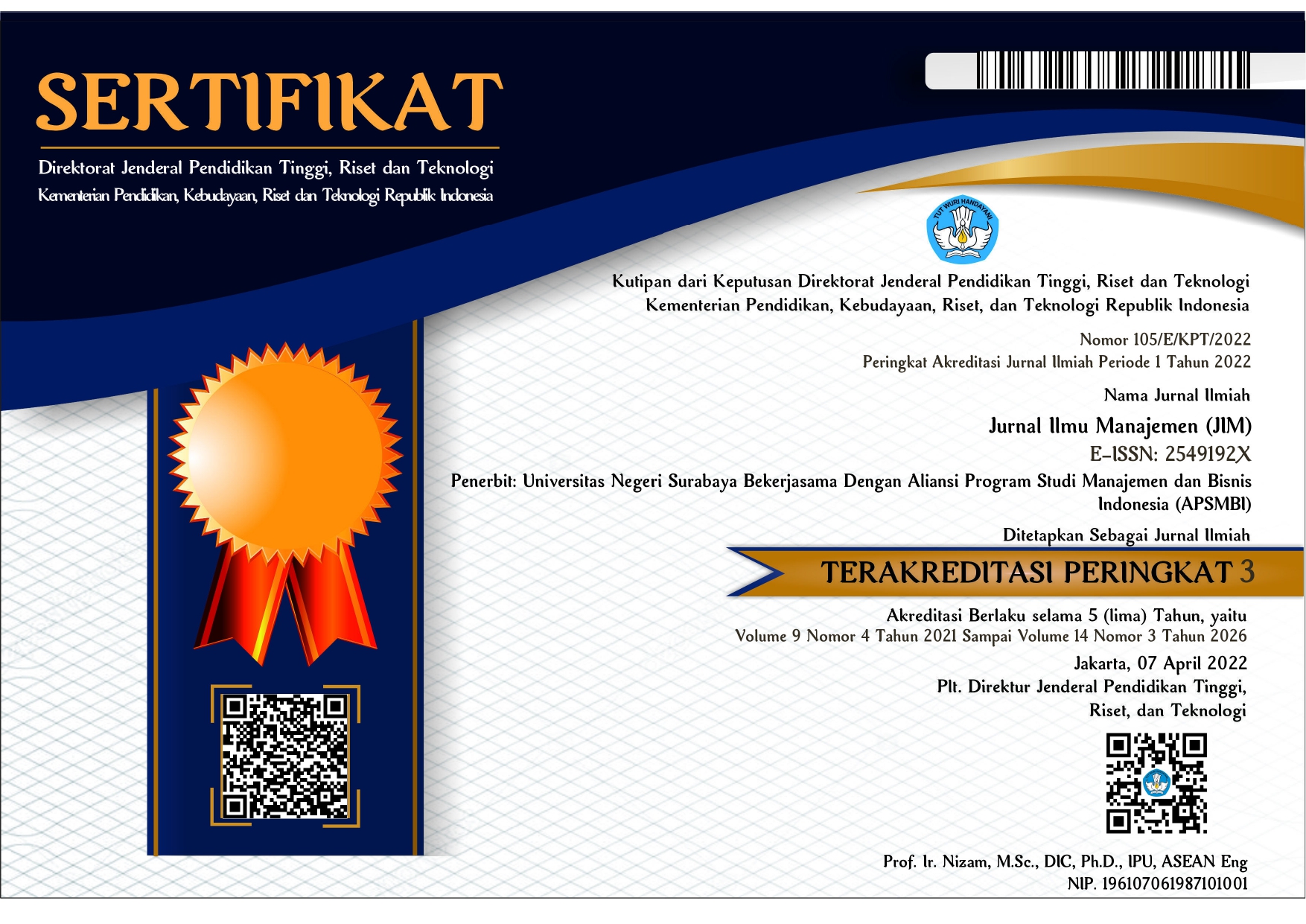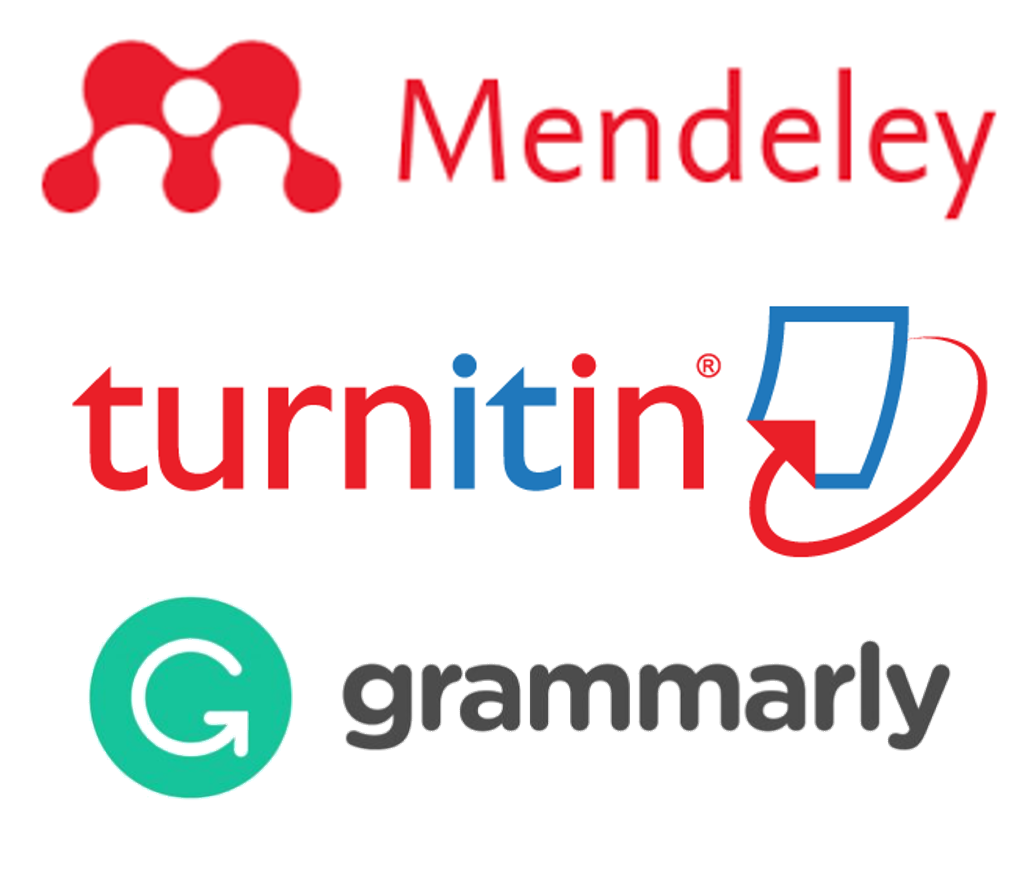Meneliti hubungan antara insentif, beban kerja, dan kinerja karyawan: Tinjauan literatur sistematis
DOI:
https://doi.org/10.26740/jim.v13n1.p106-117Keywords:
employee performance, incentives, systematic literature review (SLR), workloadAbstract
Employee performance is crucial to organizational success and is influenced by various determinants, including incentives and workload. This study presents a Systematic Literature Review (SLR) to examine the relationship between incentives, workload, and employee performance. The review synthesizes findings from previous studies to identify key trends, theoretical frameworks, and empirical evidence regarding how incentives motivate employees and how workload affects their productivity and well-being. Additionally, this study explores whether incentives can mitigate the negative impact of workload on performance. Using the PRISMA framework, research published between 2020 and 2025 was identified from databases such as Scopus. The findings highlight the dual role of incentives in enhancing motivation and job satisfaction while addressing the challenges posed by excessive workload. Therefore, Indonesian enterprises must build the appropriate incentive plan and manage workload optimally to establish a productive and healthy work environment. Long-term improvements in worker welfare and more optimal employee performance will come from the combination of well-balanced incentives and effective workload management. This study also identifies gaps in the existing literature and recommends future research directions to develop a more comprehensive understanding of these relationships.
References
Akbar, A., & Sinaulan, M. (2020). Pengaruh insentif terhadap kinerja karyawan. Jurnal Manajemen, 12(3), 45–58 . https://doi.org/10.1234/jm.v12i3.456
Ariely, D., Kamenica, E., & Prelec, D. (2009). Manifold effects of incentives on performance. In P. J. Healy & M. H. Olivetti (Eds.), Behavioral Economics (pp. 123–145 ). MIT Press.
Bakker, A. B., & Demerouti, E. (2017). Job demands-resources theory: Taking stock and looking forward. Journal of Occupational Health Psychology, 22(3), 273–285 . https://doi.org/10.1037/ocp0000056
Bakker, A. B., Demerouti, E., & Schaufeli, W. B. (2019). Validation of the job demands-resources model: A systematic review and meta-analysis. Journal of Applied Psychology, 104(3), 285–307 . https://doi.org/10.1037/apl0000367
Bloom, N., Liang, J., Roberts, J., & Ying, Z. J. (2015). Does working from home work? Evidence from a Chinese experiment. Quarterly Journal of Economics, 130(1), 165–218 .https://doi.org/10.1093/qje/qru032
Chowdhury, S., & Saha, A. (2021). Impact of non-financial incentives on employee satisfaction and loyalty. International Journal of Business and Management, 16(2), 115–128. https://doi.org/10.5539/ijbm.v16n2p115
Deci, E. L., & Ryan, R. M. (2000). The "what" and "why" of goal pursuits: Human needs and the self-determination of behavior. Psychological Inquiry, 11(4), 227–268. https://doi.org/10.1207/S15327965PLI1104_01
Deci, E. L., Olafsen, A. H., & Ryan, R. M. (2017). Self-determination theory in work organizations: The state of a science. Annual Review of Organizational Psychology and Organizational Behavior, 4, 19–43. https://doi.org/10.1146/annurev-orgpsych-032516-113108
Eisenberger, R., Shanock, L., & Wen, X. (2018). Rewards, intrinsic motivation, and creativity: A case study of the effects of rewards on creativity. Journal of Business and Psychology, 33(3), 389–400. https://doi.org/10.1007/s10869-017-9502-1
Gerhart, B., & Fang, M. (2015). Pay for performance and employee motivation: The role of fairness. Industrial Relations Research Association.
Güngör, P. (2019). The effects of financial incentives on employee performance: A meta-analysis. Journal of Managerial Psychology, 34(5), 305–323. https://doi.org/10.1108/JMP-01-2018-0025
Jenkins, G. D., Mitra, A., Gupta, N., & Shaw, J. D. (1998). Are financial incentives related to performance? A meta-analytic review of empirical research. Journal of Applied Psychology, 83(5), 777–787. https://doi.org/10.1037/0021-9010.83.5.777
Jex, S. M., & Britt, T. W. (2014). Organizational Psychology: A Scientist-Practitioner Approach. Wiley.
Kamelia, L. (2019). The impact of incentives and allowances on employee performance at PT. Arta Boga Cemerlang Bandung. Jurnal Ekonomi dan Bisnis, 10(2), 67–78. https://doi.org/10.1234/jeb.v10i2.234
Kuvaas, B., & Dysvik, A. (2009). Perceived investment in employee development, intrinsic motivation and work performance. Human Resource Management Journal, 19(3), 217–236. https://doi.org/10.1111/j.1748-8583.2009.00053.x
Maslach, C., & Leiter, M. P. (2016). Burnout: A guide to identifying burnout and pathways to recovery. Harvard Business Review Press.
Malik, M. I., & Khan, A. (2023). Balancing financial and non-financial incentives for optimal employee performance. Journal of Human Resource Management, 11(2), 92–108. https://doi.org/10.5430/jhrm.v11n2p92
Podsakoff, P. M., Whiting, S. W., Hackett, R. D., & Allen, S. J. (2019). Longitudinal effects of organizational citizenship behaviors on organizational performance: A meta-analysis. Journal of Applied Psychology, 104(6), 778–790. https://doi.org/10.1037/apl0000360
Ryan, R. M., & Deci, E. L. (2020). Intrinsic and extrinsic motivations: Classic definitions and new directions. Contemporary Educational Psychology, 25(1), 54–67. https://doi.org/10.1016/j.cedpsych.2020.101860
Salanova, M., Agut, S., & Peiró, J. M. (2016). Linking organizational resources and work engagement to employee performance and customer outcomes. Journal of Applied Psychology, 91(3), 619–630. https://doi.org/10.1037/0021-9010.91.3.619
Scopus.com. (2024). Analyze search results. Scopus. https://www.scopus.com/term/analyzer.uri?sort=plf-f&src=s&sid=8296a5da4fe551d9d46961c87667a1fc&sot=a&sdt=a&sl=63&s=TITLE-ABS-KEY%28performance+incentive+workload%29&origin=resultslist&count=10&analyzeResults=Analyze+results
Taris, T. W., & Schaufeli, W. B. (2015). The role of job demands and resources in the burnout process. Journal of Occupational Health Psychology, 20(2), 168–179. https://doi.org/10.1037/a0038591
Tremblay, M., & Gagné, M. (2020). The role of incentives in employee motivation: A review of the literature. International Journal of Management Reviews, 22(3), 378–396. https://doi.org/10.1111/ijmr.12250
Downloads
Published
How to Cite
Issue
Section
License

This work is licensed under a Creative Commons Attribution-NonCommercial 4.0 International License.
 Abstract views: 545
,
Abstract views: 545
, PDF Downloads: 288
PDF Downloads: 288











